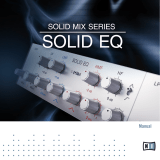Page is loading ...

Manual

The information in this document is subject to change without notice and does not represent a
commitment on the part of Native Instruments GmbH. The software described by this docu-
ment is subject to a License Agreement and may not be copied to other media. No part of this
publication may be copied, reproduced or otherwise transmitted or recorded, for any purpose,
without prior written permission by Native Instruments GmbH, hereinafter referred to as Native
Instruments.
“Native Instruments”, “NI” and associated logos are (registered) trademarks of Native Instru-
ments GmbH.
Mac, Mac OS, GarageBand, Logic, iTunes and iPod are registered trademarks of Apple Inc.,
registered in the U.S. and other countries.
Windows, Windows Vista and DirectSound are registered trademarks of Microsoft Corporation
in the United States and/or other countries.
All other trade marks are the property of their respective owners and use of them does not im-
ply any affiliation with or endorsement by them.
Document authored by: Adam Hanley
Software version: 08/2012
Special thanks to the Beta Test Team, who were invaluable not just in tracking down bugs, but
in making this a better product.
Disclaimer

Table of Contents
1 Welcome to PASSIVE EQ ............................................................................................
5
1.1 What is an EQ? ........................................................................................................................... 5
1.2 The PASSIVE EQ .......................................................................................................................... 6
2 Using the PASSIVE EQ ...............................................................................................
7
2.1 The Menu Bar ............................................................................................................................. 7
2.2 The Main Interface ...................................................................................................................... 9
2.2.1 Channel Modes .......................................................................................................... 9
2.2.2 The Middle Section .................................................................................................... 11
2.2.3 The Bands ................................................................................................................. 12
3 Credits ......................................................................................................................
15
Table of Contents
Premium Tube Series PASSIVE EQ - Manual - 4

1 Welcome to PASSIVE EQ
Thank you for purchasing PASSIVE EQ, a professional, stereo EQ created by Native Instru-
ments and Softube.
The following manual will give you an overview of the features of the PASSIVE EQ, as well as
explain how to use the software.
1.1 What is an EQ?
EQ is short for EQualizer. Technically, an equalizer (or EQ) is an audio processing unit that is
used to alter the frequency content of an audio signal. It can be used as a subtle effect, in
order to help mix tracks, or it can be used as a creative tool to radically manipulate the spec-
tral content of a sound.
EQ Types
Variations of EQ effects are very common and can be found built into many mixing desks, gui-
tar amplifiers, and even mp3 players. Sometimes, like in a guitar amplifier, the EQs are fixed
and you can only alter the gain of the bands. Sometimes EQs can be parametric, meaning you
are able to alter all of the parameters: frequency, bandwidth and gain.
There are also several variations of the shapes of EQ bands:
▪ Bell: this is the standard EQ shape: a symmetrical selection of frequencies around the
central frequency.
▪ Shelf: in shelf EQs, the amplitude control affects all of the frequencies above or below the
central frequency, dependent on whether the shelf is a high shelf or a low shelf.
▪ Filter: filters out and removes a set of frequencies. These are commonly found on subtrac-
tive synthesizers.
Like all effects, at the professional level certain specific characteristics are desired and a
handful of equipment gains popularity for being better than the rest.
Welcome to PASSIVE EQ
What is an EQ?
Premium Tube Series PASSIVE EQ - Manual - 5

1.2 The PASSIVE EQ
The PASSIVE EQ is a stereo, 4 band parametric EQ with lowpass and highpass filters. It is
modeled after an analog EQ famous for its smooth and natural sound, which is greatly desired
by professional engineers and producers. It uses tube amplifiers and has a true stereo topology
which make it both sweet sounding and flexible.
The PASSIVE EQ takes the hardware one step further, by adding mid/side processing, and ster-
eo linking options. These increase the possibilities, without losing the character of this famous
EQ.
Welcome to PASSIVE EQ
The PASSIVE EQ
Premium Tube Series PASSIVE EQ - Manual - 6

2 Using the PASSIVE EQ
2.1 The Menu Bar
At the very top of the PASSIVE EQ interface, you will see the menu bar. This is primarily used
for saving and loading presets, but also has a few other functions.
The Menu Bar is located at the top of the interface.
Loading Presets
In the center part of the menu bar, you will see the preset menu. To navigate through presets,
either:
▪ Click on the left and right arrows to cycle through and load the presets one at a time, or
▪ Click on the dropdown menu to view a list of all available presets.
When using the second option, a preset is loaded when you click on its name.
Saving and Deleting Presets
To save a preset:
1. Click on the drop-down arrow to the very left of the menu bar to open the File menu.
2. Select Save as… from the menu:
Using the PASSIVE EQ
The Menu Bar
Premium Tube Series PASSIVE EQ - Manual - 7

3. Enter the name of your preset in the area under the label New Preset Name:
4. Click the SAVE button to finish the process and close the dialog box.
If you wish to remove a preset you no longer want, you can delete it by selecting Delete
from the File menu. Please note: you are not able to delete factory content.
A/B Comparisons
PASSIVE EQ offers an A/B comparison system to help you fine tune your settings.
Basically, this feature gives you two slots into which you can enter different parameter set-
tings. You can then quickly switch between the two slots to quickly compare the settings and
use whichever sounds better.
By default, you edit the parameters of slot A. To switch to slot B:
►
Click on the A/B switch located beside the preset menu.
→
You will now be editing and listening to the parameters of slot B, until you click on the
switch again.
To copy the settings of slot A to slot B:
►
Go to the File menu on the left side of the menu bar and select Copy A to B from the list.
You can also copy from B to A when editing the parameters of slot B.
Other functions
The File menu also offers the following options:
▪ Show User preset folder: opens a system window in the location of where your presets are
saved.
▪ Open Manual: opens this PDF document for reference.
Using the PASSIVE EQ
The Menu Bar
Premium Tube Series PASSIVE EQ - Manual - 8

▪ Visit Passive EQ on the web: opens your default web browser and takes you to the PAS-
SIVE EQ page on the Native Instruments website.
2.2 The Main Interface
The PASSIVE EQ Interface
The PASSIVE EQ has a dual set of controls, one for each channel. Both channels feature four
parametric EQ bands, as well as input gain, and lowpass and highpass filters.
2.2.1 Channel Modes
You can use PASSIVE EQ either in Stereo Mode, or in Mid/Side Mode. Use the switch at the top
of the interface to select a mode.
Using the PASSIVE EQ
The Main Interface
Premium Tube Series PASSIVE EQ - Manual - 9

A comparison between Stereo Mode (left) and Mid/Side Mode (right)
▪ When in Stereo Mode, the EQ processes the left and right channels separately using the
settings to the left and right of the interface.
▪ When in Mid/Side Mode, the left side of the EQ processes the sum of the stereo channels
(the mono information), and the right side processes the difference between the stereo
channels (the side information).
Mid/Side mode also gives you a balance fader, allowing you to control the ratio between
the mid and side channels, as well as Solo buttons for the channels so you can check
your settings individually.
Mid/Side processing is frequently used for widening the stereo image, but can also be use-
ful for mastering, allowing you to centralize bass frequencies, or remove nasty frequencies
that only occur in the center of the stereo mix.
Using the PASSIVE EQ
The Main Interface
Premium Tube Series PASSIVE EQ - Manual - 10

2.2.2 The Middle Section
The Middle Section Controls
Each channel has a central column of 4 controls:
▪ GAIN: This control is designed to be used to match the level of the bypassed signal with
the processed signal, making it easier to check if your EQ settings are improving the
sound or not. The range of the control is around -6dB to +4dB
▪ LP: controls both the cutoff frequency and the steepness of the lowpass filter. This can be
used to remove high frequencies in a stronger manner than just using an EQ band.
At the highest setting (18k), the filter has the steepest curve (around 40dB/octave). As
the frequency is reduced, so too is the steepness of the curve. At the lower settings, the
frequency response of the filter curve is around 18dB/octave. This gives a very smooth
sounding response between the frequency settings.
The filter can either be used as a utility filter, removing hiss or unwanted high frequen-
cies, or as a creative filter for telephone/speaker style effects.
Using the PASSIVE EQ
The Main Interface
Premium Tube Series PASSIVE EQ - Manual - 11

▪ HP: controls the cutoff frequency of the highpass filter. Like the lowpass filter, this can
either be used as a utility or creative effect, but rather than cutting the high frequencies,
it cuts the low frequencies.
The steepness of the filter remains static at around 18dB/octave, regardless of the fre-
quency setting.
▪ link: toggles the linking of the above controls between the two channels. When active, a
change in one channel is mirrored in the other channel. When disabled, you can control
the two channels independently.
2.2.3 The Bands
An example of the High Mid band
Each channel has 4 EQ bands with similar, but not identical, controls (listed from top to bot-
tom):
Using the PASSIVE EQ
The Main Interface
Premium Tube Series PASSIVE EQ - Manual - 12

▪ On/Off switch: By clicking on the name of the band, you can toggle the band on or off. The
audio is processed by the band if the name is lit.
▪ Boost/Cut: The top knob allows you to alter the level of the EQ band. The mode button be-
low it toggles between Cut or Boost mode for the knob, with the knob's label reflecting the
current mode. As you toggle modes, the mode button also changes its color from orange
(Cut) to blue (Boost). When in Cut mode, the knob is used to reduce the level of the EQ
band; when in Boost mode, the knob is used to increase the level of the band.
The range of the knob is about 20dB in both modes. Below you can see a comparison be-
tween a knob in Cut Mode (orange LED, left) and Boost Mode (blue LED, right)
▪ Bandwidth: controls the width of the frequency band, or the steepness of the EQ curve,
depending on the Band Mode.
▪ Band Mode: The band mode button below the bandwidth knob is used to toggle between a
Shelf and a Bell EQ shape for the band. Bell mode gives you control over the level of a
central group of frequencies, whereas Shelf mode gives you control over the level of all
Using the PASSIVE EQ
The Main Interface
Premium Tube Series PASSIVE EQ - Manual - 13

the frequencies above or below the selected frequency, depending on the setting.
The two lower bands will be set to low shelves, and the two higher bands will be set to
high shelves. Below you can see a comparison between a band in Shelf Mode (left) and
Bell Mode (right).
▪ Frequency: sets the central frequency of the EQ band. The range of this knob depends on
the exact band you are controlling.
▪ Link: when activated, this mirrors the settings of the linked channel to the opposite chan-
nel. When this button is inactive, the band in each channel becomes independent.
Using the PASSIVE EQ
The Main Interface
Premium Tube Series PASSIVE EQ - Manual - 14

3 Credits
Modeling: Niklas Odelholm, Oscar Öberg, Arvid Rosén, Torsten Gatu
Application Development: Volker Hinz, Maximilian Haupt, Eddie Mond
Product Design: Andre Estermann
Graphic Design: Efflam Le Bivic, Kenneth Jensen
Sound Design: Sebastian Müller
Project Management: Felix Nölken, Daniel Santucci
Quality Testing: Tom Scheutzlich, Christian Ottow, Bymski
Credits
Premium Tube Series PASSIVE EQ - Manual - 15
/







